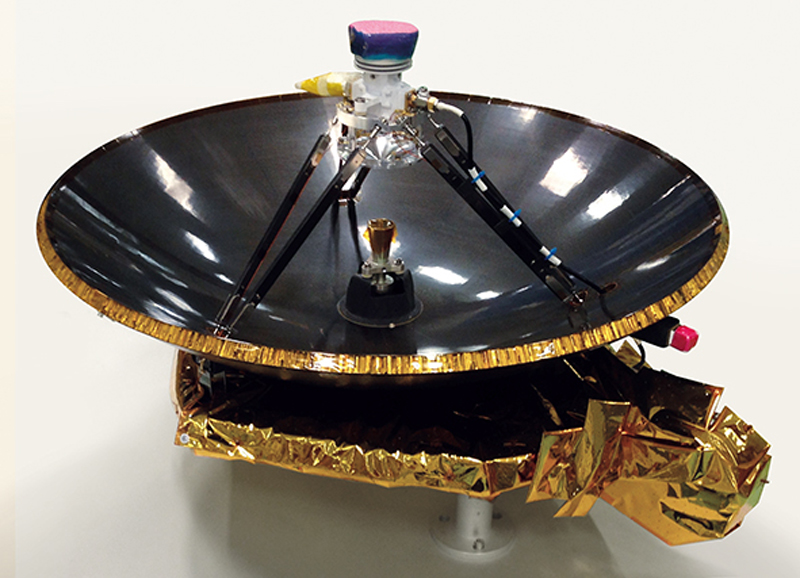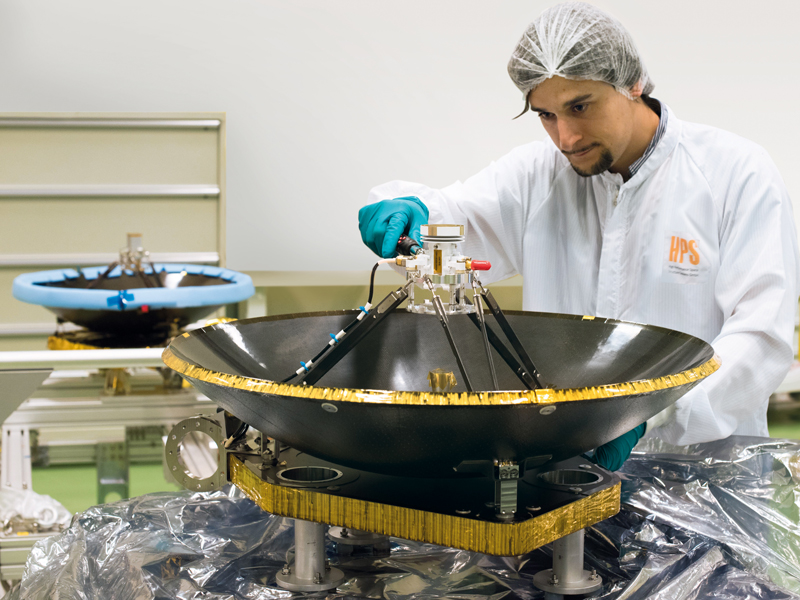State-of-the-art antenna serving one of the most ambitious missions ever
“We are opening up a treasure trove of information for scientists,” said Esa Science Director Carole Mundell. Clotilde Laigle from the “Euclid” consortium described the newly won probe of EUCLID as a “gold mine of data”.
HPS, leading provider of advanced antenna- and reflector-technologies, applauds the European Space Agency ESA to this remarkable progress in the project EUCLID (European Space Agency’s Cosmic Vision: Euclid) which aims to unravel the mysteries of the dark universe and gain insights into the nature of dark matter and dark energy.
EUCLID´s Antenna Reflector Assembly (ARA)” developed by HPS under TAS-contract represents a significant advancement in space communication technology. Its innovative design and advanced features make it an ideal choice for the mission, enabling high-speed data transmission and reception from the spacecraft to Earth and back.
“We are thrilled to contribute significantly to the Euclid mission,” says Ernst K. Pfeiffer, CEO of HPS. “Our cutting-edge technology facilitates seamless communication between the spacecraft and ground stations and allows scientists to unlock and reveal to us on Earth all those mysteries of the dark universe.”
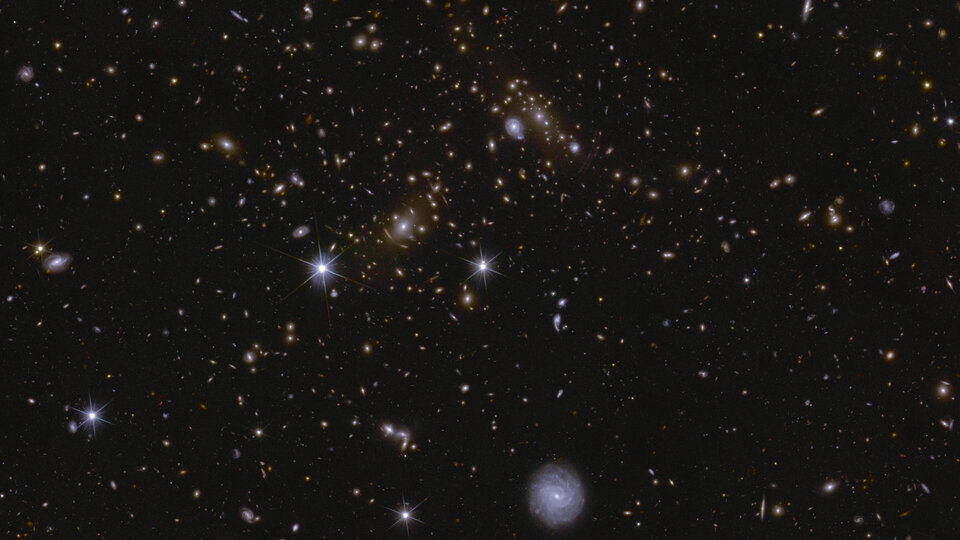
Picture by ESA
HPS congratulates ESA and TAS to the launch of EUCLID and to the successful checkout of the downlink antennan chain!
July 2023
State-of-the-art antenna to serve one of the most ambitious science missions ever
HPS, leading provider of advanced antenna- and reflector-technologies, applauds the ESA – European Space Agency and to the mission prime ThalesAleniaSpace (Italy) to the launch of space mission EUCLID (within European Space Agency’s Cosmic Vision Programme) on Saturday, 01.07.2023, which aims to unravel the mysteries of the dark universe and gain insights into the nature of „dark matter“ and „dark energy“. On Sunday, 09.07.2023 it has been confirmed that the „K-band signal has been received from EUCLID“ by the ground station on Earth.
Euclid is now the biggest transmitter of data (in terms of data rate of about 74 Mbps) from trans-lunar space: Read here the article from ESA
EUCLID´s “Antenna Reflector Assembly (ARA)” developed by HPS, together with its subcontractor Invent represents a significant advancement in space communication technology. Its innovative design and advanced features make it an ideal choice for the mission, enabling high-speed data transmission and reception from the spacecraft to Earth and back, bridging the distance of 1,5 Mio km. A deep “Thank You” for the trust into our team to our Customer Chain TAS (SP) – TAS (IT) – ESA, backed by our German Space Agency DLR.
Key features of the HPS ARA:
- Enhanced Signal Reception: The CFRP-based reflector’s high-gain capabilities, also under high temperature grades far away in L2-orbit, ensure optimal reception of the weak signals from the EUCLID spacecraft, enabling precise data collection on Earth from distant corners of the universe.
- High-Speed Data Transmission: Equipped with the reflector‘s state-of-the-art transmission CFRP material technology, the HPS-antenna facilitates rapid data transfer in K-band, allowing for real-time analysis and quick response to mission requirements.
- Robustness and Reliability: Designed to withstand the harsh conditions during launch and in space, the reflector assembly is built with durable materials.
- Compact and Lightweight: HPS` antenna design prioritizes accommodation efficiency without compromising its performance. Its compact size and lightweight construction optimize interface loads to the spacecraft and payload capacity.
“We are thrilled to contribute significantly to the EUCLID mission with our advanced reflector assembly,” says Ernst K. Pfeiffer, CEO of HPS. “Our cutting-edge CFRP-technology, developed for more than 15 years, can now play a crucial role in facilitating seamless communication between the spacecraft and ground stations, allowing the investigation of dark material by huge amount of data downloaded to Earth.”
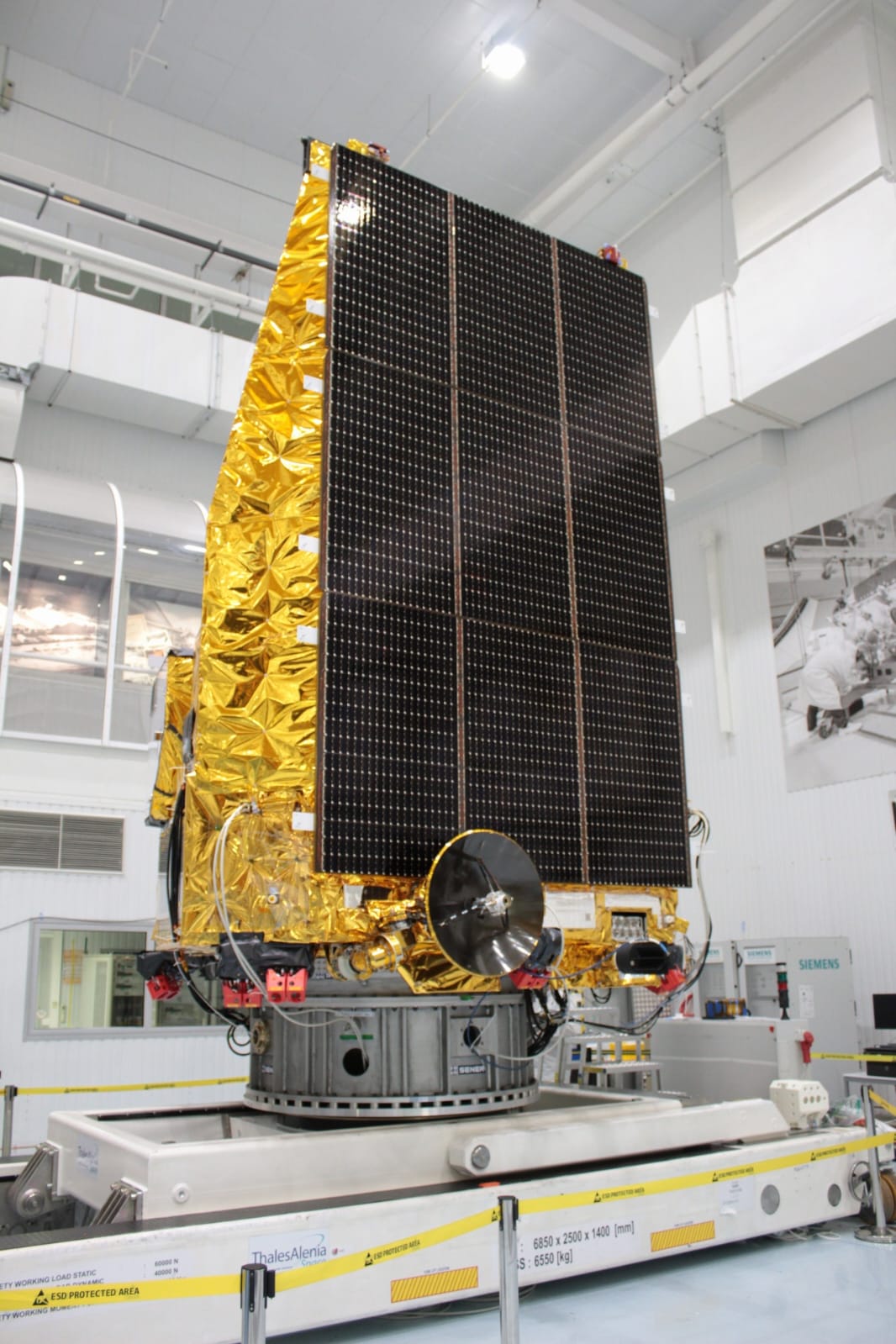
Picture by ESA
December 2017
HPS Germany receives STM-acceptance for first model of the central antenna unit
December 2015
Antenna Reflector Assembly For Mankind´s Mission to See Whether Nothing is As It Seems
When in the first quarter of the year 2020 a Soyuz launcher lifts off heading for space from the European spaceport in French Guiana it will carry a very precious payload: EUCLID, the satellite on the hunt for dark energy which is supposed to be the force behind the acceleration of the universe´s expansion. An invisible force, nevertheless dominating the universe to the extent of about 70 percent – as it seems, while matter we can see makes up for only about five percent of everything that we want to know.
Thales Alenia Space has been selected as ESA´s prime contractor for the spececraft, while Airbus Defence and Space provides the payload module. Due to the outstanding characteristics of high performance structures made by HPS in terms of RF-reflectivity, minimized mass as well as thermo-elastic distortions HPS was selected by TAS (Spain) on December 4th to provide the high gain antenna reflector structure, from which all high resolution pictures of that mission will be transmitted to Earth. The engineering center of the German space-SME in Munich will design, develop and test the product, will overlook the production of structures at INVENT GmbH, Braunschweig, of the multilayer-insulation (MLI) at its specialized subsidiary HPS lda. in Portugal, and of metal parts at SERENUM from the new ESA member-state Czech Republic.
Based on robust and intelligent technologies EUCLID will be stationed for six years at the Lagrange Point L2, 1,500,000 kilometers away from earth, on a mission to make us see beyond the seemingly.
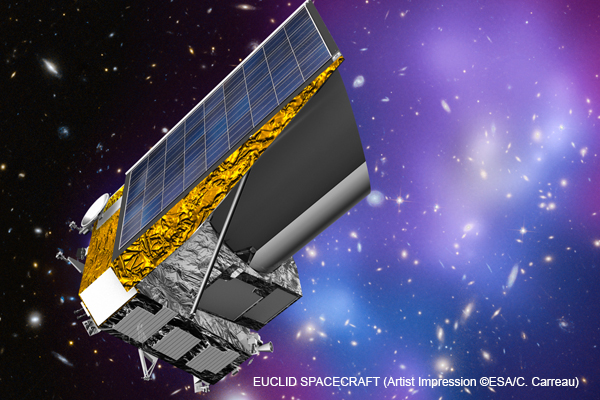
December 2017
HPS Germany receives STM-acceptance for first model of the central antenna unit
Albert Einstein is supposed to have said that only two things are unlimited: human stupidity and the universe. Concerning the universe, however, he was not sure, because the central power of gravity rather supports the contraction than the expansion of matter. Meanwhile, and based on theoretical models only, scientists are pretty certain that indeed there must be a third and even stronger power than gravity in the universe, counteracting its effects: A dark energy field, making up for 68 percent of all energy in the universe, supporting its unlimited expansion. Even more, it is believed that about 80 percent of matter in the universe consists of something that nobody has seen, yet: Dark Matter, that makes up for 27 percent of energy density in the universe, while Baryonic matter – the stuff that everything is made of that we know – contributes just five percent. Finding out about both is the target of EUCLID, the new space telescope of the European Space Agency ESA.
On June 27th, 2013, ThalesAleniaSpace Italy (TAS-I) has been assigned the task to coordinate the development of the spacecraft which will orbit the sun from 2020 to 2026 at a distance of 1.5 million kilometers from earth in order to 3D-map the Dark Matter of up two billion galaxies.
EUCLID is going to work with two instruments covering the visible and the near infrared domains.
Measurement results and stored telemetrical data will be sent to the ground station through a central adjustable antenna with a diameter of just 70 centimeters using K-Band (26 GHz) to transmit up to a max of 850 GB during four hours per day. The telemetry data are going to be transmitted via X-band; EUCLID itself is also controlled through X-band.
The Spanish subsidiary of ThalesAleniaSpace, TAS-ES, ordered the complete set of design, analysis, manufacturing, integration and testing of the K-band antenna structure assembly at the European antenna-specialist HPS Germany – the company that is highly renowned in Europe and beyond since more than 12 years for successful design and production of ultra-precise antennas for spacecrafts and satellites; absolute reliability of the EUCLID-ARA (Antenna Reflector Assembly) is simply one of the central preconditions for the success of the whole mission – a mission that is run by a consortium of almost 1,000 scientists from 100 institutes and 13 European countries plus even one from the United States. All images from both instruments on board will be transmitted via this one central antenna.
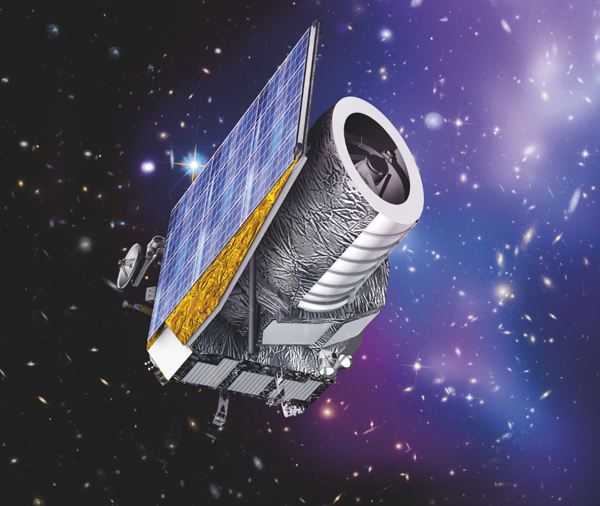
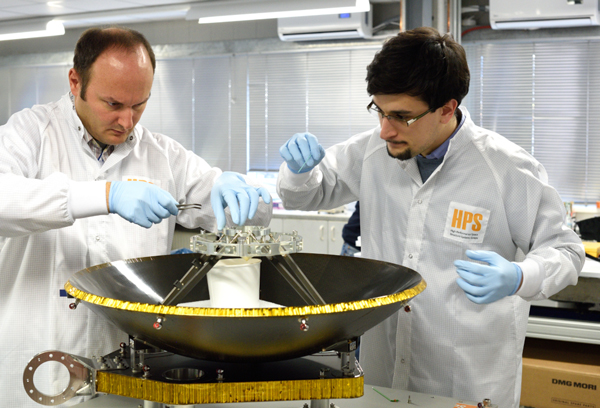
The HPS-design for the EUCLID-antenna is based on a special, highly conductive carbon fibre technology to keep the antenna extremely light, precise and robust in an environment that is characterized by widely changing temperatures at 1.5 million kilometers from earth; the antenna has to keep up reliable service out here for a mission duration of six years.
HPS has executed an detailed test campaign to verify design and technology of the reflector. The antenna proved to withstand thermal cycles and vibration tests, not only keeping the desired accuracy, but in parts even surpassing the specifications required for flawless data transmissions . To make clear what that means in practice: the permissible geometrical production tolerance here is lower than 50 µm, equivalent to the diameter of a human hair, while the acceptable degree of the antenna´s focal pointing tolerance due to temperatures between -45 and +135 degrees centigrade in space is limited up to just ten thousands of one angular degree. To put that also into perspective: this is like observing from earth the deviation of two points which are actually just 70 kilometers away from each other on the moon.
In addition, the extremely good relation of mass (4.5 kg) to rigidity (> 150 Hz Eigenfrequenz) is yet another special and valuable quality of this HPS antenna technology.
Back in May 2017 HPS delivered the first model of the K-band antenna reflector assembly, now in December it received its formal „STM-Acceptance“. Two more models follow in 2018, one of them will be the original one for the mission flight.
HPS is one of the few companies in Europe able to develop and deliver highly precise antenna reflectors. Among others, currently a reflector with 2.4 meters diameter (Q/V-band) is in production, while the qualification model of another Ka-band antenna for the German Heinrich Hertz-mission just has been successfully tested. The company´s portfolio ranges from 0.5 to 2.5-meter reflector antennas as well as for large deployable antennas from 5 to 20 meters. With this special knowhow HPS safeguards Germany´s position in the world´s top league of space antenna specialists.
September 2019
HPS hands over Euclid´s Flight Model of Antenna Reflector Assembly (ARA) to TAS-I in Rome
Euclid, ESA´s ambitious mission to map geometry and development of the Dark Universe over the past 10 billion years from 2022 on has taken a big step forward: HPS delivered the ARA-flight model hardware to ESA´s prime TAS in Rome and the communication subsystem prime TAS in Madrid after all tests (TVT, Bake-out, modal survey, optical check and main reflector contour, grounding and MLI/SLI installation) had been concluded successfully and on time.
Euclid´s ARA (Antenna Reflector Assembly) is one of the mission´s hardware keys, since it is responsible for transmitting all the scientific data, which will provide an unprecedented insight into the origin of the Universe. Extremely lightweight and stable materials have been employed in the just 4.5 kg reflector assembly to assure the demanding strength and performance requirements from the launch phase until the operations at the second Lagrangian point L2, located at 1.5 million kilometers from Earth. The high end precision in the micrometer range has been achieved in the single parts positioning during the alignment activities, allowing optimal performances in the signal transmission.
The Consortium, led by HPS GmbH (Munich based German SME) has successfully implemented the involvement of several countries across Europe. HPS would like to thank its partners for the outstanding work performed together: Invent GmbH in Germany for composite technology, SERENUM a.s. in Czech Republic for metal parts, AAC GmbH for environmental testing, FHP Ltd. in Portugal for Multi Layer Insulation technology and ONERA in France for radio-frequency characterisation testing.
Already back in 2017, HPS had successfully delivered a first Structural-Thermal Model (STM) of the Euclid ARA as well as an Engineering Qualification Model (EQM) in 2018 for testing and qualification purposes at satellite level. The delivery of the Flight Model now took place end of August 2019.
The customer chain explicitly “appreciates the effort done by HPS to fulfill the schedule dates in this complex period of the summer break and congratulates to all the good results obtained”.
